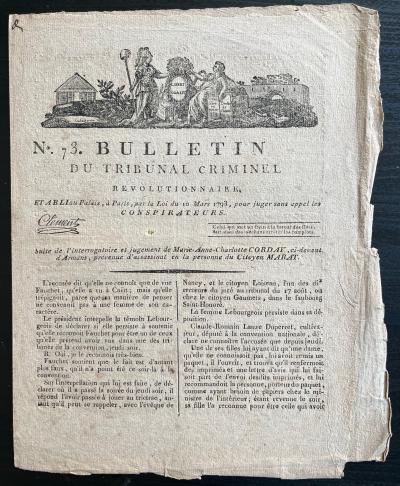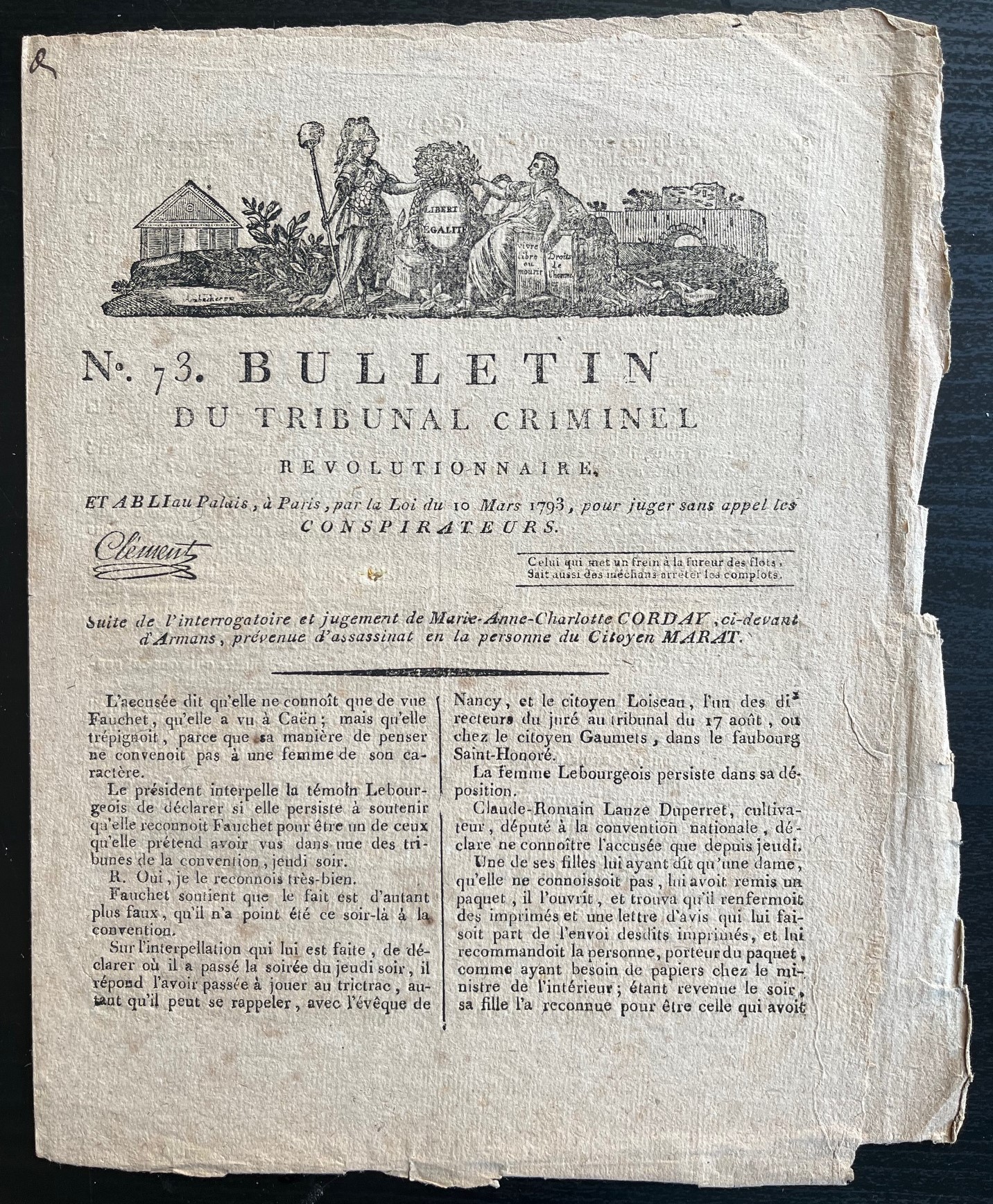Charlotte CORDET – Bulletins of the Criminal Court – French Revolution
Charlotte CORDAY [Marie Anne Charlotte de Corday d'Armont] (1768 - 1793), personality of the French Revolution, known for having assassinated Jean-Paul Marat on July 13, 1793, guillotined on July 17 of the same year.
3 bulletins from the Criminal Court, Paris July 16, 1793. 4 pages in-4°. Slight foxing.
Rare and moving testimony from the trial of Charlotte Corday, following the assassination of Jean-Paul Marat on July 13, 1793, reported in the bulletins of the Criminal Court.
The 3 bulletins are numbered from 71 to 73.
The first bulletin no. 71, handwritten in ink from July 17, 1793 at the top of the first page, has the title: “Indictment and interrogation of Marie-Anne-Charlotte Corday, ci-devant d’Armans, accused of assassination in the person of Marat, deputy to the National Convention”. Hearing of Wednesday July 17, 1793. The content of the article relates the facts as they happened and the arrest of Charlotte Corday. Antoine Quentin Fouquier Tinville, public accuser of the extraordinary and revolutionary criminal tribunal, authorized to arrest, prosecute and judge, then “read the indictment” dated July 16, 1793: The police commissioner of the section of Théâtre-Français went to Citizen Marat, alerted by the public clamor. He questioned Charlotte Corday suspected of having committed the murder. The latter was taken to the Abbey remand center, the documents in her file were handed over to the revolutionary court the same day for her trial. Then follows the details of the operations which led Charlotte Corday to her murder. Departure from Caen on Tuesday July 9, arrival in Paris on Thursday, then after an initial refusal she was able to be presented to Marat who was taking his bath on Saturday at the end of the day between seven and eight o'clock. She gave him the names of several rebel deputies from Caen. While reading, she took out a knife to hit him in the lung, which was fatal. She recognizes all the facts and her desire to kill him. The court then orders his detention at the Conciergerie.
The second bulletin n°72 has the title: “Interrogation of Marie-Anne-Charlotte Corday, formerly of Armans, accused of assassination in the person of citizen Marat”. The article gives the progress of the trial. The president calls a first witness, the accused interrupts him to explain the reasons why she killed Marat. She accuses him of having committed crimes that led to civil war and declares that she acted alone. Subsequently other witnesses intervene, Charlotte Corday validates their entire statement. The accuser seeks to know the people she frequents in Caen and the circumstances which led her to this criminal act. She only answers for her act and her personal desire to stop the madness of a criminal for the good of the people and the republic. She declares herself patriots and enemy of the aristocrats. Other witnesses follow.
The third bulletin n°73 has the title: “Continuation of the interrogation and judgment of Marie-Anne-Charlotte Corday, formerly of Armans, accused of assassination in the person of citizen Marat”. The accuser returns to the testimony of Adrienne-Catherine Lebourgeois who claims to have recognized Charlotte Corday at the national convention on Thursday evening in the company of two deputies, while the latter declares not to have left her pension. The two deputies, a bishop from Calvados and a farmer from Faubourg Saint Honoré deny these accusations. Subsequently, the accuser insists on knowing whether the accused really organized her crime alone, as claimed, or with other people from Caen, notably deputies. He does not understand why Charlotte Corday sees Marat as a danger for France when he “continued to unmask traitors and conspirators”. She always maintains that she acted alone and that there is no case in Paris where Marat is considered a friend of the people. A reading is then made of the two letters written by Charlotte Corday to Barbaroux, deputy for Caen, and to her father. The defendant's defender is called to the stand. He does not mince his words to define the abominable political fanatic that she must be to have commissioned his crime in cold blood and to feel no remorse, this moral consideration must be taken into account in the judgment that will be rendered, he concludes. The judgment is rendered, the court summarizes the facts and sentences the accused, aged only twenty-five, to the death penalty. The latter will be presented at her place of execution wearing a red shirt worn by those convicted of crimes of murder, arson or poison. His property was confiscated for the benefit of the republic. It is specified at the end of the article that “the execution took place on Wednesday the 17th of this month, around half-past seven in the evening”.
3 bulletins from the Criminal Court, Paris July 16, 1793. 4 pages in-4°. Slight foxing.
Rare and moving testimony from the trial of Charlotte Corday, following the assassination of Jean-Paul Marat on July 13, 1793, reported in the bulletins of the Criminal Court.
The 3 bulletins are numbered from 71 to 73.
The first bulletin no. 71, handwritten in ink from July 17, 1793 at the top of the first page, has the title: “Indictment and interrogation of Marie-Anne-Charlotte Corday, ci-devant d’Armans, accused of assassination in the person of Marat, deputy to the National Convention”. Hearing of Wednesday July 17, 1793. The content of the article relates the facts as they happened and the arrest of Charlotte Corday. Antoine Quentin Fouquier Tinville, public accuser of the extraordinary and revolutionary criminal tribunal, authorized to arrest, prosecute and judge, then “read the indictment” dated July 16, 1793: The police commissioner of the section of Théâtre-Français went to Citizen Marat, alerted by the public clamor. He questioned Charlotte Corday suspected of having committed the murder. The latter was taken to the Abbey remand center, the documents in her file were handed over to the revolutionary court the same day for her trial. Then follows the details of the operations which led Charlotte Corday to her murder. Departure from Caen on Tuesday July 9, arrival in Paris on Thursday, then after an initial refusal she was able to be presented to Marat who was taking his bath on Saturday at the end of the day between seven and eight o'clock. She gave him the names of several rebel deputies from Caen. While reading, she took out a knife to hit him in the lung, which was fatal. She recognizes all the facts and her desire to kill him. The court then orders his detention at the Conciergerie.
The second bulletin n°72 has the title: “Interrogation of Marie-Anne-Charlotte Corday, formerly of Armans, accused of assassination in the person of citizen Marat”. The article gives the progress of the trial. The president calls a first witness, the accused interrupts him to explain the reasons why she killed Marat. She accuses him of having committed crimes that led to civil war and declares that she acted alone. Subsequently other witnesses intervene, Charlotte Corday validates their entire statement. The accuser seeks to know the people she frequents in Caen and the circumstances which led her to this criminal act. She only answers for her act and her personal desire to stop the madness of a criminal for the good of the people and the republic. She declares herself patriots and enemy of the aristocrats. Other witnesses follow.
The third bulletin n°73 has the title: “Continuation of the interrogation and judgment of Marie-Anne-Charlotte Corday, formerly of Armans, accused of assassination in the person of citizen Marat”. The accuser returns to the testimony of Adrienne-Catherine Lebourgeois who claims to have recognized Charlotte Corday at the national convention on Thursday evening in the company of two deputies, while the latter declares not to have left her pension. The two deputies, a bishop from Calvados and a farmer from Faubourg Saint Honoré deny these accusations. Subsequently, the accuser insists on knowing whether the accused really organized her crime alone, as claimed, or with other people from Caen, notably deputies. He does not understand why Charlotte Corday sees Marat as a danger for France when he “continued to unmask traitors and conspirators”. She always maintains that she acted alone and that there is no case in Paris where Marat is considered a friend of the people. A reading is then made of the two letters written by Charlotte Corday to Barbaroux, deputy for Caen, and to her father. The defendant's defender is called to the stand. He does not mince his words to define the abominable political fanatic that she must be to have commissioned his crime in cold blood and to feel no remorse, this moral consideration must be taken into account in the judgment that will be rendered, he concludes. The judgment is rendered, the court summarizes the facts and sentences the accused, aged only twenty-five, to the death penalty. The latter will be presented at her place of execution wearing a red shirt worn by those convicted of crimes of murder, arson or poison. His property was confiscated for the benefit of the republic. It is specified at the end of the article that “the execution took place on Wednesday the 17th of this month, around half-past seven in the evening”.
This description has been translated automatically. please click here Click here to display the original language FR
End of sale
This item is not available. Please click on « View the catalog » to see similar items available.
Delivery France:
22.10 € incl. VAT (*)
Country prices, click on See
See more
Hotline
Please contact us for any question regarding this object. For any other inquiry, we invite you to fill the contact form.
Other items from the category « lettre »
.jpg)


.jpg)



